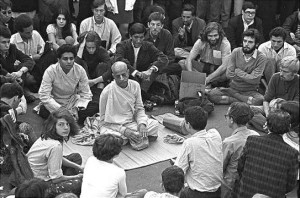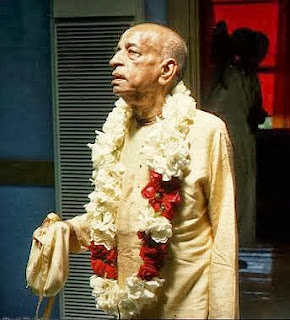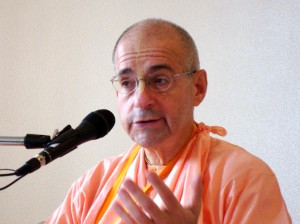ECO-Vrindaban Board Meeting Minutes – 9-29-2013.
Mission Statement: ECO-Vrindaban (ECOV) is dedicated to cow protection, sustainable agriculture, self-sufficiency and simple living — all centered around loving service to Sri Krishna, as envisioned by the ISKCON New Vrindaban (INV) Founder-Acharya, His Divine Grace A.C. Bhaktivedanta Swami Prabhupada.
Participating Board Members: Anuttama, Chaitanya Mangala, Kripamaya, Madhava Gosh, Navin Shyam, and Ranaka.
Participating Project Managers: Rafael
1. Deity Flower Garden / Trees & Berries
Flowers: Rafael reports that the flowers have been suffering from blight. They had been sprayed earlier in the season, but have not been recently. Next year a regular spraying schedule should be implemented. Other than that, the growing season is coming to an end, and the area is being wrapped up for winter.
Rafael has been watering several flowering bushes that need to be planted, but he will not be able to do so before he leaves next month.
Trees: Many that have been planted need additional caging to protect them from being further damaged by deer. The trees at Madhuban have been mulched with wood chips and cardboard, which prevents grass from growing in spaces that cannot be mowed.
Rafael mentioned that in 2014 he plans to propose hiring a permaculture expert and development of an ox-training program for the bulls that are taking birth in New Vrindaban.
2. G7G Cabin Construction
As it turns out, Tom prabhu has some experience with green building and has addressed a number of construction issues with the cabin (e.g. the need for a moisture barrier and perforated drainage pipe). A concrete floor will be installed soon.
3. Deity Dairy Project
Nityodita prabhu provided a progress report and financial review. He reported that the program was a great success because they were able to supply the cooks in the Deity Kitchen with butter, butter milk and small amounts of ghee through out the summer. Nityo’s conclusion is that one can understand Sri Sri Radha Vrindaban Chandra are pleased to be once again relishing milk products coming directly from cows lovingly cared for by Their devotees.
Gosh explained that the project was well under budget because Anandavidya and others separated the cream at the same time they were cleaning the barn, thus significantly reducing previously anticipated labor expenses. These remaining funds continue to facilitate Anandavidya’s service past the initial trial period.
Nityodita is planning to write an article for publication. ECOV Board Members look forward to reading it.
Connected to this, and as part of our overall herd management strategy, Ranaka reports that he is breeding 3 heifers, which will increase the available milk supply.
4. Sustainability Poster Display
12 posters can be displayed behind Srila Prabhupada’s Palace or in the downstairs of the Palace Lodge. The Lodge is more likely because of Jaya Krsna’s preference and because of wall mounting difficulties at the Palace.
5. Bahulaban Pink Building Demolition
Jaya Krsna & Gopisa prabhus provided the following information through e-mail:
In addition to the $10K for Savage demolition, there was $4,320 in other costs, as follows:
-
Varsana Swami had 100 hours of preparation for the pink building and the dam – $2,500 + expenses $500
-
Maharaja used for four hours the D4 = $90 * 4 = $360
-
Backhoe: 10 hours * $60 = $600
-
We have still to bury the wood – I propose to add another 3 hours for the final burying. $270
6. 2018: INV’s 50th & ECOV’s 20th Anniversary Celebrations
INV’s 50th anniversary will be in 2018. This same year will also be the 20th anniversary of ECOV. The Board agreed to regularly use meeting time to explore what projects and initiatives we would like to dedicate for that celebratory year. All directors and advisors are requested to come to these meetings with ideas and thoughts prepared ahead of time, ready for discussion.
7. Budget for Promotional Items
WHEREAS: The ECOV Board wishes to gain greater visibility in the public eye, while remaining consistent with its ecological focus.
RESOLVED: The Board authorizes up to $1,500 for the purchase of reusable stainless steel water bottles and up to $2,000 for organic cotton T-shirts (all with custom ECOV & INV logos) to be resold at various points within the community, as well as on the ECOV website.
8. Special Note
The ECOV Board Members note that several initiatives were highlighted in these minutes. These projects were completed timely, well under budget and done in a cooperative spirit that brought members of our community closer together. We pray that Srila Prabhupada and their Lordships Sri Sri Radha Vrindaban Chandra bless us with many more of these kinds of opportunities. We thank Gopisa, Varsana Swami, Rafael, Tom, Anandavidya, Nityodita and other crew members for their part in making these efforts a success.







 The Radha Krsna Temple, or now more commonly Radha Krishna Temple, was the headquarters of the International Society for Krishna Consciousness in London from the late 1960s. The Temple came to prominence when The Beatles, and especially George Harrison, started to publicly express their interest in Eastern philosophy and Krishna consciousness. The Radha Krsna Temple is also the name of an album of devotional music issued by the Temple on The Beatles' Apple Records label, produced by Harrison
The Radha Krsna Temple, or now more commonly Radha Krishna Temple, was the headquarters of the International Society for Krishna Consciousness in London from the late 1960s. The Temple came to prominence when The Beatles, and especially George Harrison, started to publicly express their interest in Eastern philosophy and Krishna consciousness. The Radha Krsna Temple is also the name of an album of devotional music issued by the Temple on The Beatles' Apple Records label, produced by Harrison 
 Gokul is a nagar panchayat in Mathura district in the Indian state of Uttar Pradesh. It is located 15 km south-east of Mathura.
Gokul is a nagar panchayat in Mathura district in the Indian state of Uttar Pradesh. It is located 15 km south-east of Mathura.  The New Talavan farm community was begun as a project in June of 1974. At first it was just a few devotees from the New Orleans temple who came out and slowly began planting gardens. They worked as time permitted and then returned to the New Orleans temple at night, a round trip of about 130 miles. Soon some devotees began staying on the farm full time.
The New Talavan farm community was begun as a project in June of 1974. At first it was just a few devotees from the New Orleans temple who came out and slowly began planting gardens. They worked as time permitted and then returned to the New Orleans temple at night, a round trip of about 130 miles. Soon some devotees began staying on the farm full time. 
 It is said that Ohrid is the, ‘meanest town in Macedonia.’ Local tradition says the Devil created Ohrid. The saying goes that when someone challenged that the town is so beautiful the Devil smiled and replied, “Yes, but the people are as mean as can be!”
It is said that Ohrid is the, ‘meanest town in Macedonia.’ Local tradition says the Devil created Ohrid. The saying goes that when someone challenged that the town is so beautiful the Devil smiled and replied, “Yes, but the people are as mean as can be!” 


 On Sunday afternoon, Mr.Rajiv Shukla, Member of Parliament, IPL Chairman, BCCI Vice President came to ISKCON Juhu for Darshan of Sri Sri Radha Rasabihariji. I talked to him that it's nice that you came to temple for darshan...
On Sunday afternoon, Mr.Rajiv Shukla, Member of Parliament, IPL Chairman, BCCI Vice President came to ISKCON Juhu for Darshan of Sri Sri Radha Rasabihariji. I talked to him that it's nice that you came to temple for darshan...  HH Bhakti Vrajendranandana Swami, ISKCON Malaysia President, has attained full consciousness. Semi-solid food is being recommended by doctors as Maharaja's appetite is gradually improving. His liver is functioning better than before. Speech clearer, physical strength picking up. In fact, Maharaja is so eager to speak that he is calling devotee on phone
HH Bhakti Vrajendranandana Swami, ISKCON Malaysia President, has attained full consciousness. Semi-solid food is being recommended by doctors as Maharaja's appetite is gradually improving. His liver is functioning better than before. Speech clearer, physical strength picking up. In fact, Maharaja is so eager to speak that he is calling devotee on phone  Vegavati devi dasi, from Iskcon Alachua, gave the Invocation at the County Commissioners Meeting. She read from the Bhagavad-gita where Krishna speaks of the particular responsibilities of leaders
Vegavati devi dasi, from Iskcon Alachua, gave the Invocation at the County Commissioners Meeting. She read from the Bhagavad-gita where Krishna speaks of the particular responsibilities of leaders 
 Sewa is a universal concept, which involves performing an act of kindness without expectation of reward. It is performed selflessly and without ulterior motive.
As a concept, Sewa in embedded in Indian traditions, and is actively promoted by different cultures and faiths - as the core belief is the same - to sacrifice your time and resources for the benefit of others without wanting anything in return.
Sewa is a universal concept, which involves performing an act of kindness without expectation of reward. It is performed selflessly and without ulterior motive.
As a concept, Sewa in embedded in Indian traditions, and is actively promoted by different cultures and faiths - as the core belief is the same - to sacrifice your time and resources for the benefit of others without wanting anything in return.  There are many purificatory processes for advancing a human being to spiritual life. The marriage ceremony, for example, is considered to be one of these sacrifices. It is called vivaha-yajna. . . . The Lord says here that any sacrifice that is meant for human welfare should never be given up. Vivaha-yajna, the marriage ceremony, is meant to regulate the human mind so that it may become peaceful for spiritual advancement. (Bg. 18.5, purport)
There are many purificatory processes for advancing a human being to spiritual life. The marriage ceremony, for example, is considered to be one of these sacrifices. It is called vivaha-yajna. . . . The Lord says here that any sacrifice that is meant for human welfare should never be given up. Vivaha-yajna, the marriage ceremony, is meant to regulate the human mind so that it may become peaceful for spiritual advancement. (Bg. 18.5, purport)